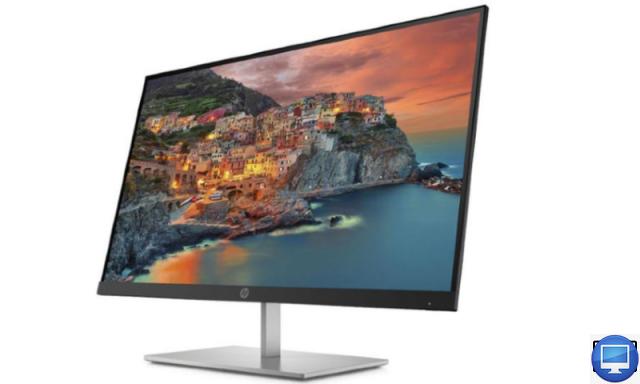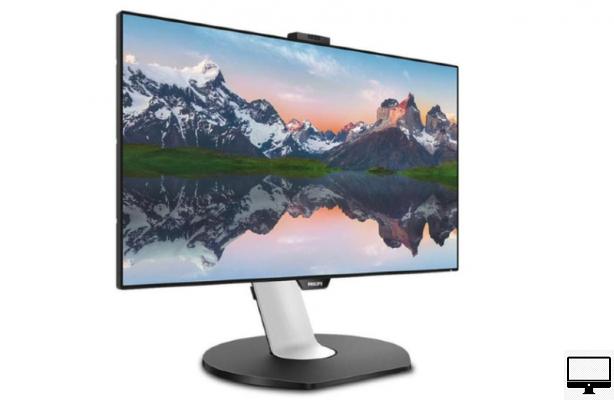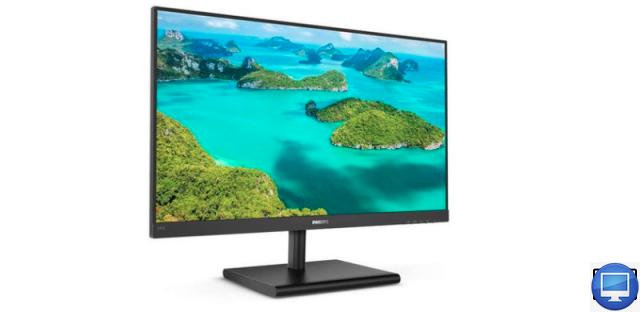
Apple's Pro Display XDR is the first monitor the brand has developed since ceasing production of the 27-inch Thunderbolt Display in 2016. Designed as the companion to the super-powerful new Mac Pro, the Pro Display is stunning, as it It's a 32-inch screen that supports 6K video. But, it is also very expensive, with a starting price of €5, and this without even a stand, so it is far too expensive for the majority of users.
However, an external display can come in very handy for any Mac user, both for work and play. Indeed, it is more pleasant to watch a movie on a big screen, or to do photo editing, etc.
Many professional users in the fields of design, photo/video editing require an external display to use their Mac mini or Pro.
Luckily, there are plenty of manufacturers that offer very attractive displays at great prices that you can use with your Mac without having to empty your savings account.
To connect a monitor to your MacBook, you'll probably need a docking station or a hub/adapter, since current laptops don't have built-in DisplayPort or HDMI ports.
At the end of our selection of the best monitors for Mac, you will find all our buying advice.
1HP Pavilion 27 Quantum Dot Display - Best of All

- Indicated price:
For many, a mid-range monitor with a QHD resolution of 2560 x 1440 is enough for a high-end 4K, it combines a sharp and detailed image, texts and graphics are easier to fix a whole day for example.
If you don't need, or can't afford a 4K display, then a 2560 x 1440 display such as HP's Pavilion 27 is a good alternative. If you're on a really tight budget, there's also a 1920x1080 resolution version for even less.
The Pavilion 27 is well-designed, with a very thin screen and bezels, which are only 6,5mm thick. HP says its "quantum dot glass" technology is very energy efficient and the display supports HDR (high dynamic range) technology for richer colors and an anti-reflective coating for better visibility.
It's not designed as a monitor for creatives, but it does support 90% of the DCI-P3 color standard, so you can use it for casual video editing, business presentations, or vlogging.
It also features HDMI, DisplayPort, and USB-C I/O, making it a good companion for the latest Mac mini and MacBook models. You'll also find a pair of USB 3.0 ports for connecting other accessories.
The only disappointment is the lack of audio support, it lacks speakers and even a headphone jack, so you'll have to rely on your Mac's internal speakers and headphone jack, or just invest in some speakers. external speakers.
2Philips Brilliance 329P9H - For a wide Premium quality screen

- Indicated price:
If you want to upgrade to an impressive 32-inch screen without breaking the bank, then go for the Philips Brilliance 329P9H.
To be precise, the 329P9H is actually 31,5 inches, it features crisp, clear 4K resolution highlighted by a nearly borderless display and anti-reflective coating. The screen sits elegantly on its adjustable stand, which allows it to be tilted, swiveled and height adjusted.
The image quality is excellent, and having the whole screen to play with is a significant luxury. However, the 329P9H also comes with many useful features.
It has two HDMI inputs, a display port and USB-C, which can act as a charger for your laptop when connected to the display. It also features four USB-A (3.1) ports, so you can use the display as a USB hub for your printer, Time Machine hard drive, and more. It incorporates stereo speakers, as well as a headphone jack, and there's even an Ethernet port.
Add to that sophisticated features, like a split-screen mode for viewing two computers at the same time, and you have a high-quality, versatile monitor.
3Philips 245E1S LCD monitor - The most compact

- Indicated price:
Philips' 32-inch display is very tempting if you're just looking for an affordable, high-quality display that you can use with a MacBook or Mac mini, then the LCD 245E1S is for you.
This 24-inch screen (23,8-inch, to be precise), offers a resolution of 2560x1440, which is above average for a screen of this size. So it will work well for streaming video, or editing some photos or videos.
To reduce visual fatigue, this Philips monitor incorporates flicker-free technology, a LowBlue mode to reduce blue light and a SmartImage game mode for gamers that adjusts response time, intensifies colors for example.
It has an HDMI, DisplayPort, and VGA interface, but no USB-C or Thunderbolt, so most MacBook owners will likely need to purchase an adapter.
On the other hand, there are no speakers, although there is an audio output connector.
Choose your Mac external screen
Display technology changes very often, with confusing technical jargon and complicated features to understand, a variety of interfaces and cables used by Apple itself and the various monitor manufacturers.
It is therefore very important, before any purchase of a monitor for your Mac, to look at several characteristics.
Size matters
If you're short on space or money, the smallest monitor size we recommend is 21 inches, which is also the size of the smallest iMac models currently sold by Apple.
There are also plenty of 22-inch monitors under $100, 24-inch ones go up to $150. Most entry-level models also offer 1920 x 1080 resolution, but for additional features prices quickly jump to $400.
If you can afford it, we recommend a 27-inch screen, the cheaper ones usually have the same 1920x1080 resolution as their smaller counterparts. However, we don't think it's worth having such a large screen for such a low resolution. It's better to have a 27-inch screen with a resolution of 2560x1440, which is about half the resolution of the latest 4K screens (at 3840 x 2160). According to the resolution 2560x1440 is more comfortable for the eyes.
However, if you want to watch a movie in all its glory, you might prefer to upgrade to a more modern 4K display, and many professional and creative users now see 4K as essential.
If you need a very large screen for your graphics or editing tasks, then you can go up to 32 inches.
Inputs and outputs
This brings us to the often confusing question of connector ports. The situation is particularly confusing right now as the traditional HDMI and DisplayPort connectors used by many monitors are beginning to be replaced, or supplemented, by newer USB-C and Thunderbolt ports.
Remember that even though USB-C and Thunderbolt cables look similar, there are actually important technical differences between them. So it's important to check which ports your new monitor uses and make sure you're buying the right cables and adapters.
Most recent MacBook and iMac models only have Thunderbolt 3 ports, in fact only the Mac mini still has an HDMI interface. If you buy a monitor that has an HDMI or DisplayPort interface, you'll need an adapter to connect your Mac.
Apart from video connections, USB-C and Thunderbolt can be used to transfer data, but also to charge your laptop, for example.
Which means these modern monitors can also double as a docking station.
Ergonomics
There's one last thing you should also think about, and it's a factor that Apple has long overlooked with its own monitors. If you have to spend a lot of time sitting at your desk staring at your screen, consider its ergonomics, the ability to tilt the angle of the monitor, rotate it for easier reading, and adjust its height to avoid pain back or neck.
Obviously “eye level” varies from person to person, so it is important that you can adjust the screen for your personal comfort.
Recommended articles:
- How to connect a 2nd screen to a Mac?
- How to connect your Macbook to your TV?
- How do I connect multiple displays to a MacBook M1?


























